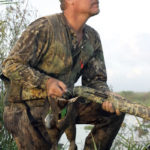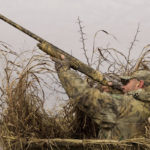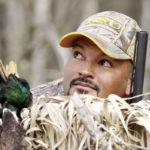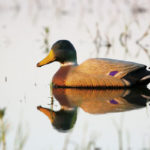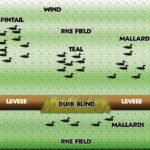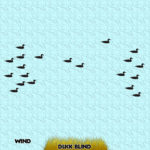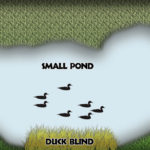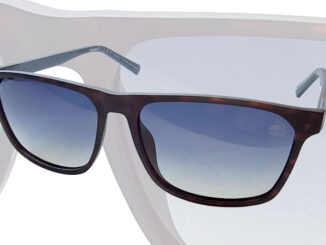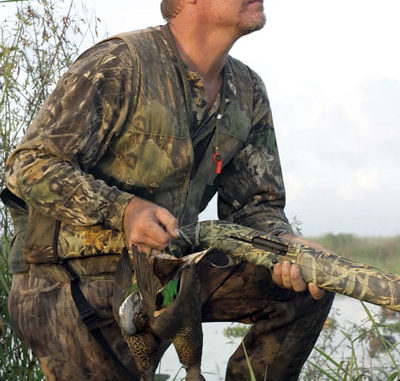
How you set out your duck decoys will make a big difference in your success level this season.
My problem with the point I’m fishing is that the bass just have to be biting better on the one across the lake.
My problem with the tree on which I just hung my stand is that the deer are walking another trail.
And my problem with the decoy spread I just threw out is that the ducks won’t respond to it nearly as well as they will a different one.
I just have to idle away from the point, climb down the tree and reposition my decoys. And, of course, my obsessive-compulsive disorder sends me home with no fish, a full rifle magazine and very few duck breasts.
Maybe my wife is right; I can’t leave well enough alone.
When it comes to duck hunting, I can’t tell you how many times I’ve been caught with my britches down among all my fake birds while trying to move them around.
If it weren’t for the sixth commandment, perhaps my blind buddies would encourage me to change the decoys more often because nothing brings in the ducks quicker than somebody stomping around in the spread.
One of my problems is that I hunt so many different kinds of places that I often get confused about which spread I’m supposed to use where. Fishook? V? Do I leave a landing strip? Should I mix pintails with mallards?
These are the answers that are frequently forgotten by casual duck hunters. Those who spend every day on the water during duck season, though? They are the ones who not only remember the answers; they just about know it all because they’ve just about seen it all.
Duck hunters like Capt. Theophile Bourgeois, who hunts just as much during the winter as he fishes, have to bring home the bacon if they want repeat business. On the other hand, duck hunters like Dennis Tietje only have to keep themselves happy.
Bourgeois almost exclusively hunts the marshes south of Lafitte, and Tietje spends all of his time hunting rice fields around Jennings. Even though there are some big differences in one’s marsh spread and the other’s rice-field set up, both hunters know how to bring in the ducks.
Marsh spread
Bourgeois has tried thousands of decoy spreads throughout his life, but the one he keeps coming back to over and over again is just about as simple as it gets. Seeing as how he mainly gets mottled ducks, teal and a few do gris south of Lafitte, Bourgeois puts out a spread that he knows they are going to like.
“First off, you’ve got to — what do they say? — match the hatch,” Bourgeois said. “If all you’ve got in the marsh is teal and gray ducks, don’t go putting a bunch of pintail decoys out.
“I find that when I put out decoys that don’t match what’s flying in the sky and sitting on the water, I don’t get nearly as many birds.”
Making every effort to put the wind at his back, Bourgeois’ ideal spread would have the back of his blind facing north with his decoy spread to his south. With predominately north winds during duck season, this is going to put the ducks landing into his face rather than over his head.
Unlike a rice field, Bourgeois doesn’t have the luxury of being able to shoot out of either side of the blind. Therefore, he makes sure what he puts out is going to present his hunters with an easy-as-possible shot with one wide shooting lane that allows birds to decoy from just about any direction.
“If you were standing in my blind, you’d see one group of decoys to the right, one to the left and maybe two little teal decoys in the middle,” Bourgeois said. “You want to try to guide them to you when you’re hunting the marsh, and that’s what this set up does.”
Specifically, Bourgeois puts 15 to 20 decoys in fist-shaped formations to his right and left that extend no more than 100 feet from his blind. These two groups of decoys are separated by an approximately 40-foot wide lane that gives decoying ducks plenty of room to land.
“Then I put those two little teal decoys right in the middle about 40 feet out from my blind,” Bourgeois added. “My landing zone extends out in a straight shot from my blind, and those two little teal are the only thing in it.”
Another advantage that this spread offers is that it presents a natural look for birds that would rather land on the lee shoreline rather than the windward one. Bourgeois has seldom seen ducks in rough water, but he’s seen tons of them rafting up in the calm water where the wind can blow right over their heads.
Rice-field spread
Like Bourgeois, Tietje has tried just about everything possible to bring more ducks into his rice fields to the west of Jennings. One of the best lessons he’s learned over the years is that the same kind of spread that worked during the first split doesn’t work so well the second.
“We get some different ducks in the rice fields that the marsh might not get,” Tietje said. “That means my decoys have to be attractive to just about anything that flies over. We have teal all year long, but by the second split we get the mallards and pintail. That’s why I use all three in my decoy spread.”
To begin, Tietje puts a big cluster of 35 to 40 teal decoys about 15 feet out in front of his blind during teal season, and leaves them there all year long. They make up the foundation of his spread because teal use the rice fields all season long.
“Teal are going to come to that cluster,” Tietje said. “But a bunch of mallards want to look at mallards on the water, so I put out three clusters of mallard decoys to my right looking from the blind. I like to separate these three clusters into groups that have three hens and two drakes.”
These mallard clusters are about 25 to 30 feet from the teal, and each cluster is spaced out about 20 feet apart. These large gaps give incoming ducks plenty of room to land.
Once the pintail start showing up in December, Tietje adds a separate group of pintail decoys that are obviously isolated from the rest of the decoys. Tietje says pintail like to stay by themselves, and his spread shows them exactly what they want to see.
“I’ll put 25 to 30 pintail decoys out in a V formation depending on the wind,” he continued. “I point the V into the wind and have the open part spreading back the opposite direction where the birds can land with the wind in their faces.”
Tietje hopes his substantial lanes between his groups of decoys and the V-shaped pintails pointing into the north wind will force incoming birds to decoy right over his pit blind secluded in a levee.
But Tietje has one more trick up his sleeve. Since he has open rice fields to his front and back, he puts out about 10 to 15 mallard decoys close to the opposite side of the levee to make them look like they’re trying to get out of the wind.
“These decoys help out a lot once the birds get decoy shy,” Tietje said. “What I’m hoping for with these decoys is that it gets them close enough that they are in shooting range when they flare.”
Freelancer’s spread
Even though Bourgeois hunts the marsh while Tietje hunts the rice fields, both are able to leave their decoys in place all season long. Although leaving decoys in place can make local birds leery of what they’re seeing, not having to pick them up and put them out means they can put out more decoys and make more intricate spreads.
What about hunters who have no choice but to pick up their decoys after each hunt? According to Capt. Eric Dumas at Lake Pontchartrain, the answer is in just a handful of decoys.
Dumas, who terrorizes the ducks just as effectively as he does the trout, loves loading up his pirogue and a half-dozen decoys to hunt the marshes in Big Branch NWR, Fritchie Marsh and the mouth of the Pearl River.
“I like to stay away from the big, open water,” Dumas said. “I look for small ponds where I can toss out just a few decoys and sit on my pirogue. Fewer decoys makes the trip a lot easier because a lot of this kind of hunting involves walking, wading and paddling my pirogue.”
Dumas says he’s at no disadvantage with six decoys. In fact, he says fewer decoys work better later in the season when he likes to hunt because the ducks are used to seeing large spreads of fake birds.
“I just throw them out and leave some places for ducks to land,” Dumas said. “But I try to put one about 15 feet in front of my upside-down pirogue blind, two or three about 20 feet off to my right and one or two off to my left. Then I’ll put out one more maybe at 30 feet straight in front.”
By picking a pond that isn’t too wide, Dumas says the ducks, which typically land on the outer edges of his spread, aren’t out of shooting range.
All three hunters tweak their decoy spreads as necessary, but they always have a reason to do so. Most small changes are made in response to wind direction, and they seldom make wholesale changes.
In other words, they’ve learned to leave well enough alone. Good thing for us they don’t mind spreading the wealth about their decoy spreads.
